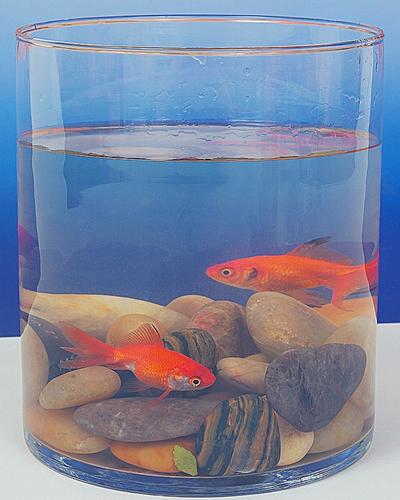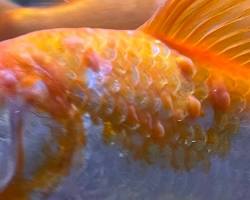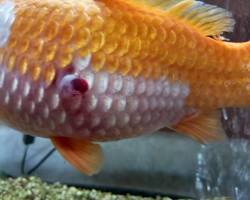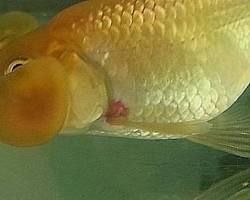Goldfish are a popular choice for fish hobbyists, known for their vibrant colors and unique markings. However, one common issue that goldfish owners may encounter is the development of red spots on their fish. These red spots on goldfish can cause concern, as they may indicate an underlying health issue that needs to be addressed.
In this article, we will explore the causes, prevention, and treatment of red spots on goldfish.
We will cover common reasons goldfish develop red spots, such as bacterial infections, parasitic infestations, and water quality issues.

Additionally, we will provide tips on preventing goldfish red patches from occurring in the first place, including proper tank maintenance, feeding, and quarantine procedures for new fish.
Furthermore, we will discuss various treatment options for red blotches on goldfish, including medicated baths, water treatments, and dietary changes. By the end of this article, goldfish owners will better understand how to identify, prevent, and treat red spots on their beloved aquatic pets.
Table of Contents
ToggleWhy Does My Goldfish Have Red Spots?
If your goldfish has red spots, it could be a sign of several different potential issues. Red spots on a goldfish may be a symptom of a bacterial infection, which can occur when the water quality in the aquarium is poor or if the tropical fish has experienced physical trauma.
It could also be a sign of a parasitic infection, such as fish lice or flukes, which can cause irritation and redness on the fish’s skin.
Another possibility is that the red patch on goldfish result from ammonia burns, which occur when the ammonia levels in the water become too high. Additionally, red spots could indicate a nutritional deficiency in the goldfish’s diet.
It’s essential to carefully observe your goldfish and monitor the water quality in the aquarium to determine the cause of the goldfish red spots. If you need help with the best course of action, it’s always a good idea to consult a veterinarian or experienced fish keeper.
What is Red Pest Disease, and how do you treat it in your fish??
Red pest disease goldfish, also known as Amyloodinium or velvet disease, is a common parasitic infection in fish that appears as tiny red or velvety spots on the skin.
The disease is caused by a single-celled organism called Amyloodinium ocellatum, which attaches to the fish and feeds on its body fluids, causing irritation, redness, and potential secondary bacterial infections.
To treat red pest disease in your fish, it is essential first to isolate and quarantine the infected fish to prevent the spread of the disease to other tanks. Then, you can treat the fish with medicated baths or dips using products specifically designed to target parasitic infections.
You can also consider adjusting the water temperature and salinity levels in the tank, as these environmental factors can help reduce the parasite’s population. It is essential to closely monitor the sick fish and continue treatments as needed until the disease has been completely eradicated from the tank.
While diseases cause red sores on a fish’s body, Red pests spread further, targeting eyes, scales, and internal organs, while Columnaris focuses on fins, gills, and mouth. The location and extent of the sores help distinguish between the two.
Red Spots On Goldfish: Symptoms, Causes & Treatments
Red patches on goldfish can be a worrying sign, but with prompt action and accurate diagnosis, you can help your friend recover. Here’s a breakdown of the symptoms, causes, and treatment options for red spot in goldfish:
Red Spot on Goldfish Symptoms:
- Red spots or patches: These can appear anywhere on the fish’s body, fins, or tail and may be flat, raised, or have a bloody streak.
- Flashing: The fish may rub itself against objects in the tank, a sign of irritation or discomfort.
- Lethargy: The fish may be less active than usual and appear withdrawn.
- Loss of appetite: The fish may stop eating or show reduced interest in food.
- Fin clamping: The fish may hold its fins close to its body, indicating pain or stress.
- Ulcers: In severe cases, red spots can develop into ulcers.
Red Spots on Goldfish Treatment:
- Isolate the affected fish: This is crucial to prevent the spreading of any contagious disease. Set up a quarantine tank with clean, well-conditioned water.
- Improve water quality: Daily water changes to remove ammonia and other toxins. Test the water parameters regularly and ensure optimal levels for gold fish.
- Medicated baths: Depending on the suspected cause, medicated baths with specific medications for bacterial infections, parasites, or fungus may be recommended. Consult a veterinarian or experienced aquarist for guidance.
- Salt baths: A short-term salt bath can help reduce stress and promote healing. Use aquarium salt as directed and monitor the fish closely.
- Maintain a healthy diet: Provide a balanced diet of high-quality goldfish food to help your fish rebuild its strength.
Goldfish Red Spot Disease Prevention:
- Maintain optimal water quality: Regular water changes, proper filtration, and appropriate stocking levels are crucial to preventing aquarium issues and fish diseases.
- Quarantine new fish: Always quarantine new fish for at least two weeks before introducing them to the main tank to prevent the introduction of any diseases.
- Provide a healthy environment: Avoid overcrowding and ensure adequate hiding places for your goldfish.
- Offer a varied diet: Feed your goldfish a balanced diet of pellets, flakes, vegetables, and occasional live or frozen food.
Seeking professional help:
If the red spots worsen, the fish exhibits other concerning symptoms, or you’re unsure about the cause, consult a veterinarian or experienced aquarist for proper diagnosis and treatment. They can perform tests and recommend specific medications or treatments tailored to your goldfish’s needs.
Remember, early intervention is crucial for successfully treating goldfish red spots. By promptly observing symptoms, identifying the cause, and taking appropriate action, you can help your beloved finned friend recover and thrive.
What Causes Red Spot Disease in Goldfish?
Red spot disease, also known as red blotch disease, is primarily caused by a virus known as Grapevine Red Blotch Virus (GRBaV). The feeding activity of the three-cornered alfalfa hopper and the meadow spittlebug transmits this virus.
Once the virus infects the grapevine, it impairs the plant’s ability to produce specific proteins, leading to red spots on the leaves. These red spots result from reduced chlorophyll production, causing the affected leaves to develop a red or blotchy discoloration.
The virus can be spread through the use of infected plant material as well as by the vectors themselves. Unfortunately, there is currently no cure for red spot disease, and the best management method is to remove infected vines and control the insect vectors to prevent the further spread of the virus.
Vineyard managers and growers can also take preventive measures such as using virus-free planting material and monitoring for signs of infection to reduce the risk of spreading disease within their vineyards.
3 Main Causes of Goldfish with Red Spots
There are three main culprits behind red patches on your goldfish:
#1 Reason: Goldfish Red Pest Disease & Bacterial Infection:
This is the most common cause, often stemming from bacteria like pseudomonas, flavobacterium, or viruses. These opportunistic bacteria thrive in poor water conditions or when a goldfish’s immune system is compromised. Red spots can vary in size and location, sometimes developing into ulcers or sores.
#2 Reason: Parasites
Tiny external parasites like flukes and flatworms can burrow into the skin and gills, causing irritation and red bumps or patches. These parasites also weaken the goldfish, making them more susceptible to secondary infections.
#3 Reason: Ammonia Poisoning
Ammonia, nitrites, and nitrates build up in an unmaintained tank, poisoning the goldfish and reducing their ability to fight off disease. The stress from poor water conditions can also manifest as red spots on the body.
Here are some additional points to consider:
- Location: The location of the red spots can offer clues to the cause. Red spots around the mouth often indicate mouth rot, while spots on the fins or gills suggest parasites.
- Other symptoms: Look for signs of illness like flashing, lethargy, fin clamping, or difficulty breathing.
- Use Water testing kits: Regularly test your tank water for ammonia, nitrites, and nitrates to ensure optimal levels.
If you notice red marks on goldfish, acting quickly is crucial. Improve the water quality immediately and isolate the affected fish. Consulting a veterinarian or experienced fishkeeper can help determine the exact cause and recommend the best course of treatment.
Remember, early diagnosis and intervention are essential to successful treatment and a speedy recovery for your goldfish.
Signs Your Fish Has Red Spot Disease
Red spot disease, columnaris, or cotton mouth disease, is a common bacterial infection among fish, particularly freshwater species. One of the most noticeable signs of this disease is the appearance of red or white spots on the fish’s body, fins, or mouth.
Infected fish may also exhibit lethargy, loss of appetite, and inflammation in the affected areas. They may also display abnormal swimming behavior, such as darting or rubbing against objects in the tank.
The red or white spots may develop into ulcers as the infection progresses, causing further tissue damage. It is important to promptly recognize and treat red spots on gold fish, as it can quickly spread throughout the tank and infect other fish.
Upon observing these symptoms, it is recommended to quarantine the infected fish and seek professional advice from a veterinarian or experienced aquarist to determine the best course of treatment.
– Blood red blotches at the base of fins
If you notice blood-red blotches at the base of your fish’s fins, it could be a sign of Red Spot Disease. This bacterial infection can lead to inflammation and necrosis, ultimately causing a loss of fins and even death. It’s important to quarantine the affected fish and treat the tank with antibiotics to prevent the spread of the disease to other fish.
– Red patches goldfish and red veins in the tail fin
If you notice red patches on your goldfish and red veins in their tail fin, it could be a sign that your fish has Red Spot Disease. A parasite causes this condition and is most commonly seen in goldfish. Red Spot Disease can be treated with medication, but it is important to quarantine the affected fish to prevent the spread of the parasite to other tank inhabitants. Make sure to consult with a veterinarian or fish expert for proper diagnosis and treatment.
– Red pest causes blood red spots or patches on the fish’s body.
If you notice blood red spots or patches on your fish’s body, it could be a sign of red spot disease caused by a parasitic infection. This condition, also known as red pests, can affect various species of fish and can lead to severe skin damage and even death if left untreated. Look for unusual markings on your fish and consult a veterinarian or fish expert for proper diagnosis and pest disease treatment for goldfish.
How To Treat Red Spot Disease in Fish?
how to treat red spots on goldfish? Red Spot Disease, also known as Hemorrhagic Septicemia, is a bacterial infection that affects fish. It is characterized by red spots or patches on the skin, fins, or gills, along with other symptoms such as lethargy, loss of appetite, and rapid breathing.
If you suspect your fish may have Red Spot Disease, here are some steps you can take to treat goldfish with red spots:
- Isolate the infected fish: Transfer the infected fish to a separate quarantine tank. This will help prevent the spread of the disease to other healthy fish in the main tank.
- Improve water quality: Ensure that the water in the quarantine tank is clean and properly maintained. Regularly test the water parameters such as temperature, pH, ammonia, and nitrite levels. Perform water changes as needed to maintain optimal conditions for the freshwater aquarium fish.
- Administer antibiotics: Consult a veterinarian specializing in fish diseases to obtain the appropriate antibiotics for treating red spot disease in aquarium fish. Follow their instructions regarding dosage and duration of treatment. Some commonly used antibiotics for fish include tetracycline and erythromycin.
- Maintain good nutrition: Provide the infected fish with a balanced and nutritious diet. This will help boost the fish’s immune system and aid recovery. Offer a variety of high-quality fish foods suitable for the species of fish you are treating.
- Monitor and observe: Keep a close eye on the fish’s condition during goldfish red spot treatment. Look for any signs of improvement or worsening of symptoms. If the fish’s condition deteriorates or new symptoms arise, consult a veterinarian for further guidance.
- Disinfect equipment and tank: After the infected fish has recovered or if it unfortunately doesn’t survive, it’s crucial to thoroughly disinfect the quarantine tank and any equipment used during the treatment. This helps prevent the spread of bacteria and other pathogens to future fish.
Remember, it is always recommended to consult with a veterinarian specializing in fish diseases for an accurate diagnosis and appropriate treatment plan. They can provide tailored advice based on your fish’s specific needs and the infection’s severity.
Utilize Aquarium Salt for Treating Goldfish Disease Red Spots.
While aquarium salt can be a helpful tool in treating some goldfish diseases, it’s crucial to identify the specific cause of the red marks on goldfish before using it. Different ailments manifest with red spots, and using the wrong treatment could harm your goldfish.
Here are some common goldfish diseases with red spots and their treatments:
Carp Pox: This viral infection causes raised, red bumps or growths on the skin. Aquarium salt is not effective against carp pox. Treatment typically involves supportive care, including maintaining good water quality and providing a nutritious diet.

Red Pest Disease (Costia): This parasitic infection causes small, red sores or ulcers on the skin and fins. Aquarium salt can help treat red pest disease goldfish. You can add 1 tablespoon of aquarium salt per 3 gallons of water to the main or hospital tank. Perform 100% water changes every 3 days and continue red pest disease treatment for 7-10 days after the last signs of the disease disappear.

Goldfish Ulcer Disease: This bacterial infection causes open sores or ulcers on the skin and fins. Aquarium salt can be used as part of the treatment for goldfish ulcer disease. Add 1 tablespoon of aquarium salt per 2 gallons of water to the main fish tank or a hospital tank. Perform 50% water changes every other day and continue treatment for 7-10 days after the ulcers have healed.

Essential things to keep in mind before using aquarium salt:
- Always use aquarium salt made explicitly for fish, not table salt or rock salt, which can contain harmful additives.
- Monitor your goldfish closely for signs of stress, such as gasping for air or clamped fins. Aquarium salt can be harmful to some fish, especially in high concentrations.
- Do not use aquarium salt with other medications unless directed by a veterinarian.
- Gradually remove aquarium salt from the tank after treatment is complete. You can perform small, frequent water changes over several days.
If you need more clarification about the cause of the red spots on your fish, it’s best to consult with a veterinarian or a qualified fishkeeper. They can help you diagnose the problem and recommend the best course of treatment.
Commonly Asked Questions about Causes of Red Pest Disease (FAQs)
How do you treat red spot disease in goldfish?
Treat red pest disease in goldfish with antibiotic medications targeting Aeromonas bacteria. Isolate infected fish, improve water quality, and consult a vet for severe cases.
Why do my fish have red spots on them?
Why does my goldfish has red spots? Red spots on fish can indicate various issues like bacterial infections, parasites, or trauma. Check water quality, observe behavior, and consult a vet or experienced fishkeeper for accurate diagnosis and treatment.
How do you Cure red sores in fish?
Curing red sores depends on the cause. Improve water quality, isolate affected fish, and choose specific treatments: antibiotics for bacteria, parasite medication, or fungus salt baths. Consult a vet for severe cases.
How do you treat red fins in goldfish?
Red fins in goldfish could be fin rot (bacterial or fungal). Improve water quality, consider medicated food or aquarium treatments, and monitor closely. For severe cases, consult a fish vet.
How do I get rid of red spots on my goldfish?
Identifying the culprit behind goldfish red patches is critical! Improve water quality, isolate affected fish, and observe behavior. Depending on the cause (bacteria, parasites, etc.), consider medicated food, aquarium treatments, or consulting a fish vet.
What are the pink spots on my fish?
Pink spots could be harmless (lymphocystis) or signal issues like: – Parasites, bacteria, or fin rot. Check water quality, observe behavior, and consult a vet or experienced fishkeeper for diagnosis and treatment.
Why does my dead fish have red spots?
Unfortunately, identifying the cause of red spots on a deceased fish is difficult. These spots could be pre-existing or related to the death process. It’s best to consult a veterinarian or experienced aquarist for further insights while focusing on maintaining optimal water quality for the remaining fish.
How to treat goldfish with red spot on head?
To treat goldfish with a red spot on its head, isolate it, change tank water, and add aquarium salt. Use antibacterial medication if needed. Consult a vet for persistent issues.
How to cure red spots on goldfish?
To cure red spots in goldfish, improve water quality, use aquarium salt, and apply antibacterial treatments. Ensure optimal tank conditions, and consult a vet if symptoms persist.
Why does my goldfish has red spots on its body?
Red spots on goldfish body often indicate infections or parasites, commonly due to poor water quality or stress. Check water parameters, improve tank hygiene, and consult a vet if needed.
Conclusion
In conclusion, red patches on goldfish could indicate various health issues such as ammonia burns, parasitic infection, bacterial infection, or genetic factors. It is essential to closely monitor the presence of red patches and observe any changes in the behavior of the goldfish. Suppose the red spots are due to poor water quality. In that case, it is essential to immediately improve the tank environment and perform regular water changes to prevent further damage to the fish.
Suppose the red blotches are a result of a parasitic or bacterial infection. In that case, it is crucial to seek the advice of a veterinarian specializing in fish care to provide the appropriate goldfish red spot treatment. Genetic factors may also play a role in the appearance of red spots on goldfish, and in such cases, there may not be much that can be done to prevent or treat them. Overall, monitoring the overall health and condition of the goldfish and taking appropriate actions when necessary is vital in maintaining their well-being.
You might also like
- Help! Black Spots on Goldfish: 3 Causes & Quick Solutions
- Bubble Eye Goldfish 101: Comprehensive Beginners Care Guide
- Goldfish Sickness: 7 Common Goldfish Diseases & Quick Fixes!
- Goldfish Dropsy or Pregnant: Don’t Miss These 7 Clear Signs!
- Goldfish Mating or Fighting: 7 Red Flags You Should Know!
- White Patches on Goldfish 101: Quick & Easy Goldfish Care




